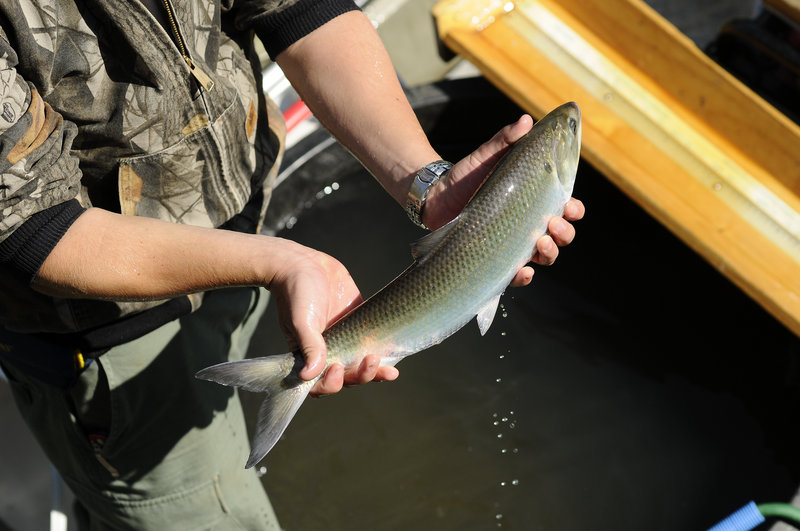The shadbush are in bloom, their small white flowers standing in stark contrast to the otherwise bland riverbanks this time of year.
New England lore claims that shadbush blooms annually when shad return from the Atlantic to spawn in local rivers. For many years, it seemed like just another regional folk tale, as shad were visibly absent from local waterways.
American shad are sometimes referred to as a “poor man’s salmon” for several reasons. They are anadramous, spending their adult lives in the ocean but returning to freshwater rivers to spawn. The shad population also declined drastically as dams sprouted up along eastern waterways, closing off traditional spawning grounds. And, once hooked, they fight, run, and may leap like a salmon.
Shad have made a comeback in Maine. Thanks to a hatchery program in the mid-1990s that was spearheaded by the Department of Marine Resources (DMR) and aided by local hatchery in Waldoboro, returning shad are a familiar sight in the Kennebec River system.
“We stocked tens of millions of larval shad in the lower Kennebec, and what we are seeing now is the resurgence of the shad population. I think that we have hit the critical mass point, where the population seems to be slowly expanding,” said Nate Gray, a fisheries scientist with DMR.
Shad are members of the herring family, and bear similar characteristics to alewives and blueback herring, with one major difference. While adult alewives are 10-12 inches in length, adult shad returning to spawn are generally in the 3-5 pound range, and can grow up to 9 pounds and 30 inches in length.
The increase in the number of returning shad has sparked an interest in fishing for shad in Maine.
“There is a dedicated, expanding cadre of anglers seeking shad,” says Gray, “Anglers are anglers, they like to fish, and shad put up a good fight on the end of the rod. Slowly, the popularity of the fishery is rising.”
Shad return to Maine shortly after alewives. This time of year, you may find alewives stacked up near the base of a dam or falls, and shad in the deeper pools, flashing from side to side at times.
Anglers have had success fishing in the Saco, Androscoggin, the Kennebec, and their tributaries.
Shad will often hold in certain areas, waiting for water to warm up before heading upriver. A gradual warming period will bring shad further upriver. Cold fronts, or prolonged rainy periods will keep shad holding.
If you locate where they are holding, you are likely to catch multiple shad. Angler logs submitted to DMR show nights with slow fishing, but also show evenings with 20-30 fish landed.
As with most species, dawn and dusk are the best time to fish. Seek out runs or riffles where tributaries hit the main stems of rivers. Warmer tributary water will often hold shad as they wait for the main stem of the river to warm up before migrating upriver.
The most popular method for fishing is spinning gear, rigged with either shad darts or flutter spoons. Fly anglers will use neutral or sinking line, with small clousers and bonefish flies. Brightly colored lures and flies are the preferred choice, as they stand out in the tea-colored water of our larger rivers
Since shad fishing is in its infancy in Maine, not many tackle shops carry equipment but you can find a nice selection of gear and fishing reports on the web at places like Woo’s Fishing.
With spinning gear, use a lighter, braided line since darts and spoons are relatively light. Many anglers will tie a weighted shad dart to their line, attach a 12-inch leader to the hook of a dart and then a flutter spoon. Swing your line through these holding areas, or bounce the dart of the bottom.
Just where to go is a learning experience, but good places to start include the mouth of the Cobbossee River in Gardiner, the Fort Halifax area of the Sebasticook in Winslow and the Lockwood Dam in Waterville.
And as for timing, according to Gray, there’s no time like the present.
“Starting right about now, and continuing right into June, shad fishing should be at its peak.”
Mark Latti is a Registered Maine Guide, and the Landowner Relations/ Recreational Access Coordinator for the Department of Inland Fisheries and Wildlife.
Send questions/comments to the editors.



Success. Please wait for the page to reload. If the page does not reload within 5 seconds, please refresh the page.
Enter your email and password to access comments.
Hi, to comment on stories you must . This profile is in addition to your subscription and website login.
Already have a commenting profile? .
Invalid username/password.
Please check your email to confirm and complete your registration.
Only subscribers are eligible to post comments. Please subscribe or login first for digital access. Here’s why.
Use the form below to reset your password. When you've submitted your account email, we will send an email with a reset code.